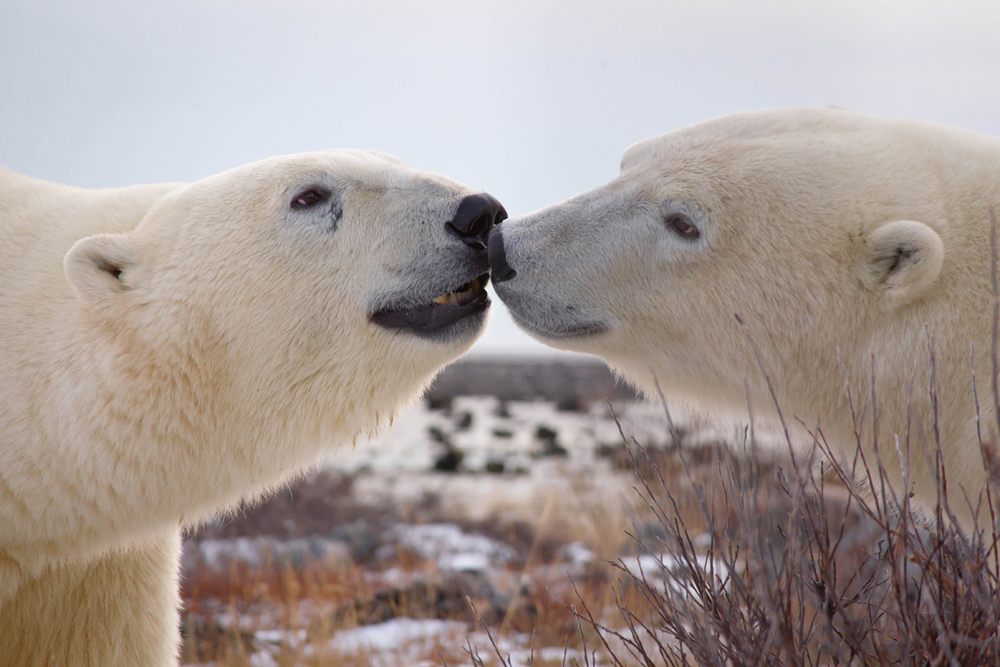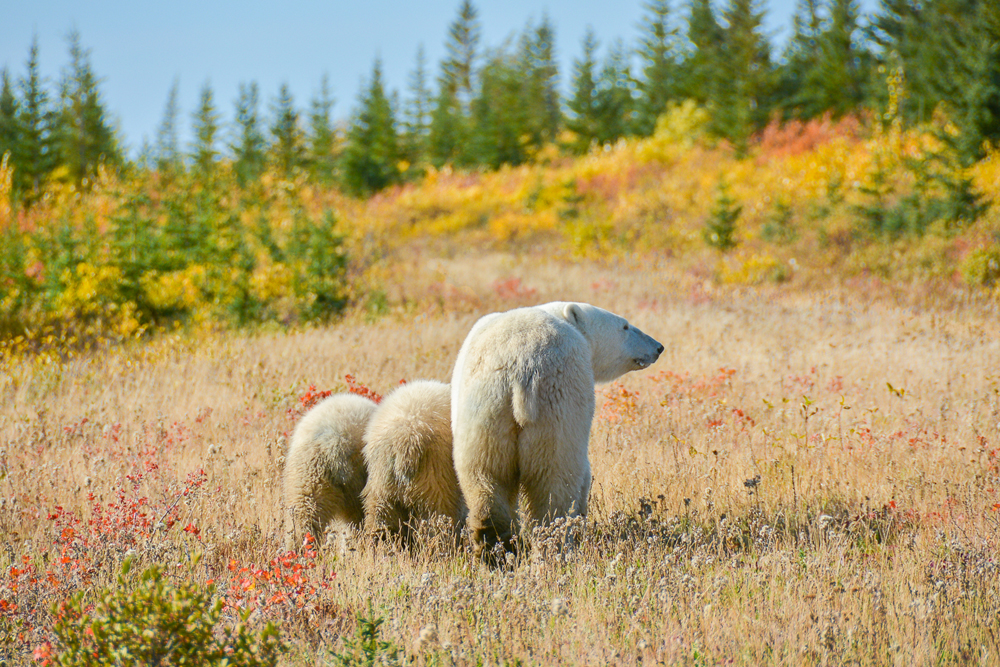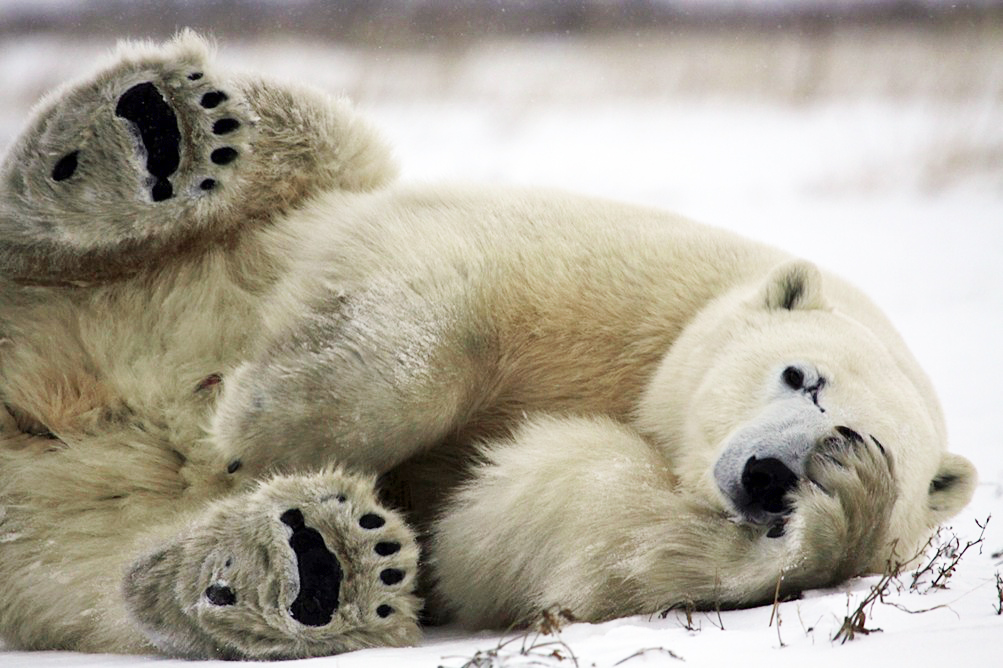There are many cultures that revere polar bears. Some even have their own monikers for the great white bear. The Inuit call them Nanuk, (Hey, that’s just like the name of our Nanuk Polar Bear Lodge! What a crazy coincidence.) meaning an animal worthy of great respect, the ever-wandering one. In Eastern Greenland, polar bears are known as Tornassuk, the master of helping spirit. And The Ket, a Siberian Tribe, refers to the polar bear as Gyp or Orqoi, which means grandfather or stepfather, a sign of respect and awe.
No matter what you call them, it’s an amazing experience to view polar bears in the wild. And before you head out on your polar bear adventure, here are a few more cool things to know.
1.) Don’t expect to hear them before you see them
Polar bears are not very vocal mammals. They tend to transmit their intentions through body language or posturing. For example, polar bears will wag their heads from side-to-side when they want to play. Hissing, snorting or a lowered head indicate aggression while a nose-to-nose greeting indicates a request for something from another bear. When they’re angry though, they will roar or growl. Thankfully, our expert guides know how to interpret these signals and keep all our guests safe while on the ground with these amazing creatures.
2.) The same but different
Polar bears have different personalities as a result of varied life experiences, but at their core all bears have the same basic nature. Polar bears are very intelligent and therefore playful and curious. This curiosity makes them tolerant of us as we explore their habitat on foot and experience life-changing encounters.
3.) They’re an ancient ancestor of the brown bear
Studies have shown that polar bears actually evolved from an ancestor of the brown bear into the polar bears we know today. Over a period of perhaps millions of years, they have become perfectly suited to survive the harsh, seasonal shifts of the Arctic environment they now call home. For example, they have a thick layer of fat (up to 11.4 cm!), beneath their fur, their ears and tails are small to limit heat loss, and their wide paws allow them to safely cross the sea ice.
4.) Not all who wander are lost
Polar bears don’t have distinct territories, partly because their sea ice habitat is always changing. When a young polar bear breaks away from its mama, it’s believed that it may travel more than 1,000 km to establish its own home range. Scientists believe that most polar bears stick to an area that covers no more than a few hundred. However, there has been one satellite-tracked female that covered nearly 5,000 km while monitored.
5.) They’ve mastered sleep quality (and quantity)
Humans could learn a thing or two from polar bears about getting enough rest. They get their seven to eight hours at night plus they nap during the day. We often see evidence of this, in the form of day beds created in snowbanks or tall grass, around our Lodges. Polar bears will usually nap after a meal or a swim or if it’s too hot or too blustery…they nap a lot. They can sleep right through a blizzard if they position themselves with their backs to the wind, nestled into a snowy ridge.
6.) A mother’s love
One of the most incredible things about polar bears is their ability to delay implantation of a fertilized egg. Mating takes place on the ice during the spring, between April and June, but the embryo will only implant in the fall and only if the mother has stored up enough fat to sustain herself and her cub(s) during the denning season. If the implantation is successful, she will build a maternity den and remain there until March or early April when the proud new momma emerges with her cub(s).
7.) They know all about stealth mode
Ringed seals, a polar bear’s choice meal, cut breathing holes in the ice, using the sharp claws on their fore flippers. They maintain these openings throughout the winter and surface about every five to fifteen minutes at one of these holes. Some estimates state that a polar bear can smell its prey from up to 64 km (40 miles) away, and once they locate these openings they will camp out for hours, or even days, waiting for the seals to emerge.
You’d think a seal would notice a polar bear creeping up on it but bears are very adept at hunting seals that are basking out on the sea ice. The bear will approach slowly, freezing if the seal looks in its direction, then, when he’s sufficiently closed the gap, the bear will use its explosive speed to pounce, killing the seal before it can escape back into the sea.
8.) The more fat the better
While many humans try to limit their intake of fat, polar bears have a slightly different mentality: the more fat, the better!
A polar bear can eat up to 100 pounds of blubber in a single sitting. And when the hunting is good, they get choosy and will eat only the fat, leaving the carcass for scavengers. Unfortunately for seals, some of the polar bear’s best hunting is done in early summer as the ice breaks up, just as young seal pups are learning to swim, making them easy prey.
9.) Their fur isn’t actually white (fur real!)
A polar bear’s fur is made up of a dense, insulating layer and longer “guard” hairs on top. This dual-layer system prevents almost all heat loss — so much so that adult males can easily become overheated when they run. And, surprise! Their fur isn’t actually white, it just looks that way. Each hair shaft is actually pigment-free with a hollow core that scatters and reflects light.
10.) Paws-itively all-purpose
Polar bear paws are very wide, up to 30 cm across, and this helps the bears when they’re traversing thin ice. Remember those socks you used to wear as a kid that had little rubber grips on the bottom? Polar bears have something similar on their footpads called papillae which help prevent them from slipping and sliding on the ice. They also have fur between their toes and footpads to help with traction. And polar bear paws aren’t just good for icy conditions. When swimming a polar bear’s front paws act like large paddles, while its hind paws serve as rudders.
Do you have a question about polar bears? Send it to us we’ll do our best to answer it for you!











